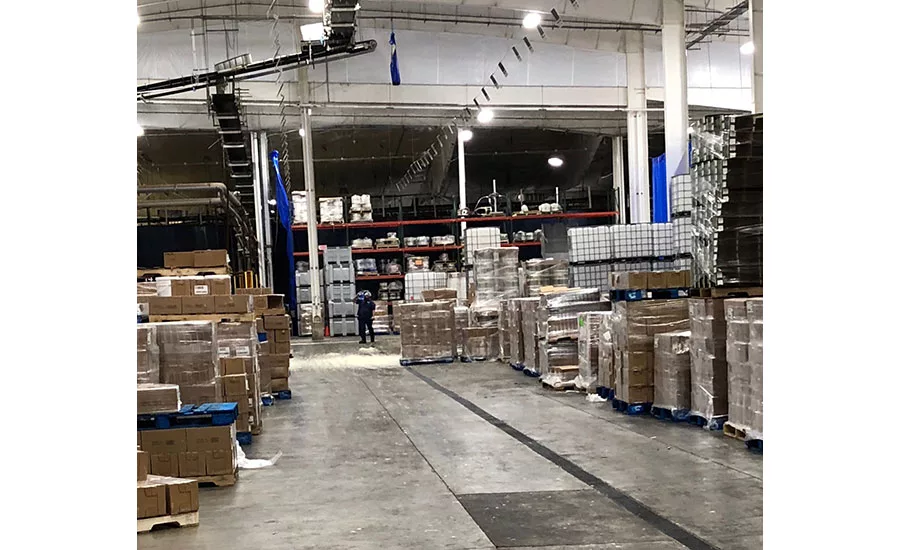Field Reports
Pallet flow racking system triples storage, streamlines production
Using vertical space, a Steel King racking system enables manufacturing and storage space consolidation at GLK Foods, eliminating off-site storage and double-handling.

Before GLK Foods’ new pallet racking was installed, the product was not stackable so pallets were stored in single file across the floor. Photo courtesy Steel King Industries.

After GLK Foods installed the Steel King pallet flow racking system, they tripled their storage space and streamlined production. Photo courtesy Steel King Industries.
Kraut producer GLK Foods has experienced so much growth that they have had to implement some industry best practices in terms of optimizing storage and production.
When the family owned fourth-generation’s Bear Creek, Wis., facility reached its onsite storage capacity and required offsite storage during the busy fall harvest season, Brad Froberg, plant manager, needed a solution.
“We were looking to triple our available pallet storage and streamline production at our existing facility,” says Froberg. “We run product year-round, but in the fall, as cabbage crops come in, we have to ramp up our production lines for a specialty kraut product.”
According to Froberg, previously pallet floor storage was utilized in the facility for the specialty kraut product. The product was not stackable, so the pallets were stored single file across the floor.
“The challenge was that inventory processing and inventory storage all went through the same room and became a production bottleneck. This led to leasing offsite storage and the inefficient double handling of product,” says Froberg.
Froberg consulted with Wisconsin Lift Truck, a material handling distributor in the Midwest, whose representative, Mark DeCleene, recommended an approach to streamline the facility’s available storage and lift truck fleet management.
The approach utilized a SK3400 Pallet Flow system from Steel King Industries, a designer and manufacturer of warehouse material handling, storage and safety products with a national dealer network.
Such pallet flow racking is designed to store up to 100% more product than selective racks and reduce aisle space by 75%.
However, to optimize pallet flow, more planning and precision can sometimes be required than with traditional storage. With pallet flow, dynamic flow rails are inclined in a static rack structure, allowing loads placed on one end to move by gravity on rollers to the unloading end, with speed controllers acting as gentle brakes.
When pallet flow is properly designed and installed, as each pallet load is removed, the pallets behind it move forward automatically. Once loaded, first-in first-out (FIFO) product rotation is automatic. Forklifts are only required for the initial loading and final unloading because the rack eliminates the labor and forklift operation required to arrange loads in traditional racking.
Because the dynamic flow system height, width and depth were limited only by the size of the facility and capabilities of the material handling equipment, it was a good fit for GLK Foods’ space efficient, high volume needs at the Bear Creek facility.
With 850 pallet positions in racking five levels high, the pallet flow system exceeds 27 feet and was built with SK2000 Closed Back Tubular Rack for strength and durability. “We selected a robust racking system that is able to resist forklift damage. By design, the closed back rack is safer, stronger and more durable than an open back rack,” says Froberg.
To take full advantage of the facility’s vertical space, the pallet flow system was installed to a height of 27 ½ feet. Access to the top racks is enabled by the use of a high-reach fork truck, as recommended by Wisconsin Lift Truck.
“The pallet flow system has tripled storage space at our facility, while streamlining processing and production,” says Froberg, “We were able to increase our in-house storage capacity by about 25 trailer loads of product. So, we are not shipping it to offsite storage and then bringing it back again.”
According to Froberg, this approach not only eliminates the cost of leasing offsite storage space but also eradicates the double-handling of product.
“Over the fall harvest period, we are probably saving about 150 hours of forklift double-handling alone,” he says.
The greater pallet storage density has opened up floor space in the facility, which enables putting more separation between product lines, as well as enhances safety, productivity and cleanliness, according to Froberg. “The pallet flow system has eliminated our storage and production bottleneck and is improving our effectiveness,” he explains. “The storage consolidation will also help us accommodate future growth within our facility, which was previously not really possible.”
In addition, Froberg says that having the specialty kraut product stored in-house is easier to control and rotate with FIFO capability than having to monitor and oversee product in offsite storage. “The logistics is easier with in-house pallet flow storage with automatic FIFO, which helps to ensure proper product rotation,” he says. “That is not the case when coordinating shipping to offsite locations for storage is necessary.”
For more information, visit www.steelking.com.
Looking for a reprint of this article?
From high-res PDFs to custom plaques, order your copy today!






